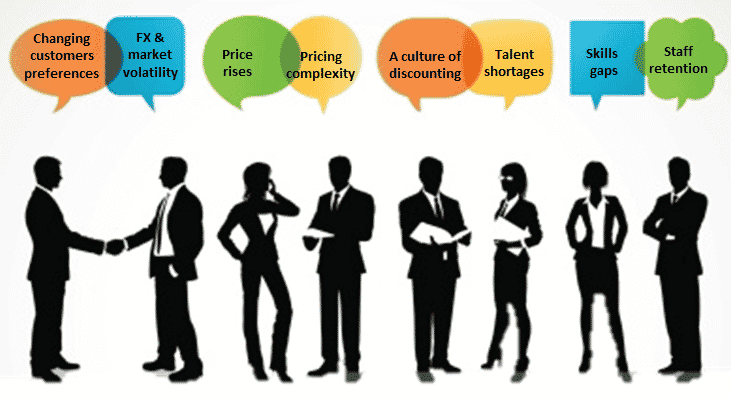
Pricing Manager Job Description: Why Pricing Managers Are Set Up To Fail
What is a pricing manager job description? Why do people in pricing jobs oftentimes don’t succeed?
>Download Now: Free PDF Pricing Recruitment
Table of Contents:
I. Pricing Manager Job Description: Why A Job In Pricing Is Often Set Up To Fail
II. Pricing Manager: How To Advance Your Pricing Career & Earn More Money
III. How to Position your Pricing Manager Career & Team for Success
IV. Pricing Career: No. 1 Challenge Preventing Pricing Executives From Success
V. Head Of Pricing Jobs: Things Managers Will Never Tell You About Pricing
VI. Pricing Jobs: The Secret To Winning Better Pricing Jobs

What is a Pricing Manager Job Description? Why Pricing Jobs are Often Set Up to Fail
Pricing professionals often tell me that gaining trust, buy-in and alignment around pricing is the toughest part of the job. All too often, pricing managers and analysts join new teams with hopes of achieving great results and building their careers. Only to find they are pretty much on their own. Fighting against unsupportive and siloed business environments with chaotic pricing operations and pricing systems.
No matter what company or industry, the topic of pricing raises natural concerns, questions and even conflict between teams and functions. When you look at the causal drivers for this, the pricing team’s major problem can be traced back to how the pricing team and function were set up in the first place.
For example:
- Many pricing executives are hired into pricing roles under false pretences (pricing manager job descriptions often do not represent the actual job, culture and team dynamics experienced.)
- Pricing managers often enter businesses with a latent culture of compliance
- Existing teams are expected to work effectively with the new price leadership team with no prior engagement or input into the role of pricing and the new team
- Sales teams are expected to work effectively with a function without knowing exactly how they should work with the new pricing team and implement new ideas and changes
- New pricing teams often work with organisations that are weary about changing old pricing approaches and struggle to gain traction in the business
In this article, we will discuss how to recruit and set up a pricing team in the best way possible. In subsequent articles, I will give real-world examples of how leading FT500 have set up and recruited their pricing teams using more commercial and innovative recruitment alternatives.
Our contention is that the recruitment model is broken into two main reasons:
1) its main focus is on one-off commission fees (not its customer’s business objectives)
2) it lacks the capability to find and set up cohesive and specialist pricing teams and create positive business environments.
Many businesses (without even knowing it) are at risk of margin loss from inadequate recruitment processes. Heavy reliance on a traditional recruitment model will mean that businesses will increasingly struggle to cope with the demands of specialist pricing hires and building high-performance pricing and commercial teams.
The problem with pricing manager job description and recruitment
The traditional recruitment model is falling short to build high-performance pricing teams in B2B businesses. Pricing executives are typically recruited into businesses that have not fully addressed their pricing control function, team and culture situation. All the while, businesses expect their new and existing teams to work together to achieve substantial revenue, margin and profit growth without giving them first adequate training and support.
Business leaders have ready access to a number of potentially game-changing commercial ideas and resources at their fingertips. It can be tempting to chase after a new SAP integration (pricing tools software) to complex pricing issues, rush into hiring (weak pricing manager job description), or follow new research on cloud pricing because they all seem to provide some relief or a solution to a complex problem. What’s harder, but far more valuable, is to embrace the business problem and address it at the root.
Spend some time with your teams understanding your pricing situation and commercial challenges right now until they no longer pose a threat. Study them from various viewpoints and angles, and understand them on a deeper level. Rather than narrowing the scope of your final decision and options by rushing to hire a pricing team, remain receptive to the important problem – one tied to customer value, teams and commercial structures.
Uncomfortable truths will surface. You may find silos and too many priorities. You may even be top-heavy and conflict avoidant. Also, you may be inspired to rip out business units, break down customer and product data, P&Ls and integrate new pricing teams with existing teams in ways you have never done before.
How leading businesses build their commercial teams with a good pricing manager job description
To address complex HR and commercial challenges, progressive businesses like DHL, TPI /Cleanaway and GE are choosing to utilise more adaptive, commercial and innovative recruitment alternatives. A primary driver for change is the need to keep up with changing and unprecedented times.
Many recruiters do not have the requisite pricing expertise or commercial knowledge to understand the requirements for technical and niche pricing management roles and draw up a useful pricing manager job description or recruit for the role. An under-investment in recruitment coupled with a poor understanding of pricing will automatically affect how, what, and who you place into key pricing management roles.
Any business that competes on value has to realise that to implement pricing strategies and grow, it must first innovate and figure out how its HR initiatives and recruitment activities can yield talented teams that work well together and are better prepared and empowered to deal with complex problems.
The lack of culture change
When the pricing function is not thought out or designed to fit the business prior to a new team coming on board, its purpose and effort can be diminished by well-intentioned but harmful pricing bureaucracy, endless reports and analysis that does not get either read or acted upon. Even effective teams can be rendered ineffective when there is a lack of buy-in, mandate or support from key stakeholders in the business.
It can be a mistake to rush into hiring pricing executives into the business without first defining the role of pricing in your business (pricing manager job description) and understanding exactly how the new pricing team fits in with your existing sales processes and teams.
Inadequate recruitment practices can lead to revenue and margin loss let alone substantial recruitment costs and wasted time and effort. If you want your sales and pricing teams to work well together and reach goals under tight deadlines, existing teams must first be engaged with the development of the new pricing team before they come on board.
When existing teams understand the role of pricing in their business (due to a clear pricing manager job description) and they know what to expect from the new pricing teams, they trust (rather than reject) the support and expertise of the new pricing team.
〉〉〉 Get Your FREE Pricing Audit 〉〉〉
What you can do about the right pricing manager job description
Consider “what’s needed – and what works” if you’re thinking of hiring a new pricing manager or analyst. Even if you’re simply replacing an existing role. It’s a new brand of recruitment that emphasises a 360-degree approach to recruiting and setting up a specialist pricing team. An approach that draws upon external outreach to stakeholders, extensive ties to sales and marketing managers and teams, expandable organisational structure tiers, and flexible membership to critical business transformations and projects.
Leading businesses, like DHL, Shell, GE, Parker, and Caterpillar are overcoming significant commercial challenges by addressing their value, teams and commercial structures. They think long and hard about the role of pricing and match their recruitment needs against their specific commercial requirements and business culture to find the right people and create a strong senior manager job description (which is also applicable to a pricing manager job description).
The composition and set-up of a team can make or break a new pricing actions function. Take care to think about the composition of your team in relation to your commercial requirements and business culture.
Who should the pricing function report to? What responsibilities should the pricing function hold? In addition, what skills and qualifications does a pricing manager need to have to solve pressing commercial challenges? What is pricing accountable for versus sales and marketing in the generation and delivery of revenues and margins that meet or exceed budget? A pricing manager job description is essential for a job in pricing to be successful.

Pricing Manager Job Description: How To Advance Your Pricing Career
A pricing manager and team can be the saviour one day, watching the EBIT gains come in after developing a sophisticated quoting tool. And, the enemy the next day, dealing with customer and stakeholder complaints and credit notes after a mismatched price rise. (An action most likely implemented to improve profitability quickly by a state, region or branch, but a result for which the pricing team is held largely accountable).
Getting a seat at the leadership table as a pricing executive is neither straightforward nor clearly mapped out. There are a growing number of large corporates in the USA, EU and ANZ with pricing executives on the leadership team (Rockwell, Caterpillar, Parker, GE), but this is not the norm.
Many pricing managers complain that there is nowhere to go after the role, or there are limited promotion opportunities for the leadership team.
Many pricing professionals re-focus their career path to marketing or finance because they struggle to find a suitable strategic pricing role at a senior level in dealing with price pressure. If you have expertise and passion as a pricing manager, Taylor Wells believes that moving away from pricing management is a mistake. Pricing management is a growing field and will continue to be so. It is better to stick through the stormy waters now, develop your skills, and reap the benefits later.
B2B businesses need pricing expertise to drive commercial strategy and business model innovation in ever more complex B2B environments. However, a career as a pricing manager is not for the faint-hearted; requiring pricing competency, a positive attitude, persistence/energy, as well as a realistic career game plan.
What is holding you back? Pricing Manager Job Description
There is an expectation out there that if you just work hard enough, produce some long hours and do great work, the CEO and executive teams will notice and promote you. Unfortunately, this does not happen as much as you think or would like. There are executives in your organisation, ready to take credit for your good work – a tough reality, but all too common.
There’s also an assumption or stereotype in the marketplace that analytical people are introverted, conservative, and reserved in groups who are more likely to have trouble ‘fitting in’. It’s pretty fair to say that high calibre pricing and commercial executives are conscientious. They also tend to be high achievers and results-focused. They may even lean towards the introverted end of the scale.
However, what most executives tend to overlook about successful pricing professionals is that they get such impressive results because they have mobilised, engaged and led teams. This includes educating and informing sales, marketing and product teams on new pricing concepts and frameworks (previously unknown to most people). Also, utilising the skills and capability of the group to make the best pricing decisions and recommendations.
Job shortages
There is a shortage of strategic pricing roles and opportunities at the senior level. Even though pricing management is a growing field and function in Australia, the majority of pricing roles (although growing rapidly in numbers) are still tactical and operationally focused.
Many pricing professionals struggle to find roles that are ‘suitable for their level, skills and capability. It is common for pricing professionals to settle for what they know rather than move to new companies largely because they fear they’ll make a bad career decision.
On the other side of the equation: There are very few businesses with objective insight into the capabilities of pricing people and teams. Consequently, recruitment, promotion and talent management programs tend to miss out on evaluating the right mix of skills and competencies that are required for executive pricing roles.
What can you do about it? Pricing Manager Job Description
1. Understand your core strengths & capability
Securing the top jobs in pricing inevitably requires certain traits and characteristics (for a full discussion, please refer to my earlier article: “How to win great jobs in pricing”. But let’s not forget that getting the top jobs in pricing also takes a fair amount of honest self-reflection, focus and dedication.
If you want to advance your career and unlock your full potential, you need to understand how well you do what you do, and why you do it. You need to consciously put yourself in the right role and business. You need to manage derailing behaviours. Moreover, you need to seek out targeted training programs that will bridge any skills gaps you may have.
Successful people in pricing tend to seek out objective feedback from people they trust and who have insight into their world and expertise. Many sit career assessments and have in-depth reports on their pricing capability, personality and teamwork skills. Some build a network of professionals that can give them confidential and impartial feedback on their performance, the market, and suitable job opportunities.
It takes more than past experience or an impressive CV or LinkedIn profile to get noticed and stand out from a crowd. A CV says nothing about how well you perform best. It is risky relying on your CV or LinkedIn profile to get noticed by hiring companies, as it may attract the wrong companies. Check out our blog on price analysis.
2. Choose to work for companies that invest in people and pricing
Oftentimes, companies do not measure hiring as the “quality of hire” but as to how they fill jobs quickly. If you think of changing jobs, and you know you have great skills, it makes sense to concentrate your effort on businesses that look at both measures.
Sure, there will be more businesses that focus on time to hire over the quality of hire, but this means that you’ll be saving yourself the headache of explaining yourself without reciprocation. Read Price recruitment: Take Control of Recruitment and Test Before You Hire.
Having the right experience and skill set is just part of the puzzle. If you do not like how a job advertisement is written, and or the initial screening with the hiring manager(s), chances are you will not like the job, culture and values of the business (see customer value pricing). And, chances are that your unique skill set and expertise will be nullified or underappreciated.
3. Get a career game plan
Getting ahead in pricing isn’t about luck. Top executives don’t wait for opportunities to happen to them. They have built a successful career after clear and thoughtful planning and many seek career counselling. In addition, they know the right career options for them based on objective evaluations of their personalities, behavioural patterns, skills, capabilities and background. Furthermore, they seek advice from experts to advance their careers.
Career counselling and career planning tools can provide impartial insight into personal values, interests, ability levels and potential. They give practical advice on how to manage strengths effectively to consistently elevate performance. When you understand the depth and breadth of your capabilities, potential, and the quirks of your personality, it is possible to learn to appreciate the processes you have created to function in the world.
Targeted skills and career counselling will support you make small shifts that ensure your career is on the right track and you are in the right place. Collectively, these shifts can have a profound impact on performance, career, salary and well-being.
People are not held back because of some elusive and mysterious weakness. They are held back because they do not know their value and or have not aligned their value to the right company (i.e. they are in the wrong place, need more focused training and support or they are deploying the wrong behaviours).
More of the same is not always the best way to advance your career in pricing. There are many executives and senior leaders that lose their jobs because their strengths become weaknesses through overuse. Oftentimes, the very traits, capabilities and personal characteristics that launch careers and mark a person out for promotions are the same characteristics that can derail that same career down the line.
〉〉〉 Get Your FREE Pricing Audit 〉〉〉
Remember:
We all have blind spots and unconscious biases that bind us to a set of routine thought processes and feelings that govern how we live and interact with others (otherwise known as our comfort zone). We work best when we adapt and step outside our comfort zone and try something that feels strange, awkward and uncomfortable to begin with. But which accelerates our progress towards our chosen target or ideal role.

How to Position your Pricing Manager Career & Team for Success
Recently, I have had a number of my readers ask me:
“Where can I take my career in pricing and commercial strategy now that I am a senior pricing manager?”
“Can I go into a leadership position from pricing?”
“How can I position my team to get respect, recognition, and results in my business?”
These are great questions and go deep to the heart of an individual’s and organisation’s belief system about value. For example, if a company truly believes that pricing is its number one profit lever, there is no way a shrewd CEO or CFO wouldn’t have it reporting directly to them. There would be too much money and shareholder value at stake as key to the commercial strategy of the organisation.
When the CEO makes pricing and people top priorities and sets up a pricing reporting line that goes directly to the C-suite, you know that real business transformation is taking place. You also know that your company is looking to your team to deliver results, leadership and shareholder value.
Pricing Manager Job Description for Commercial Careers
To perform well under the watchful eye of the CEO, a pricing team needs executive leadership team buy-in and strong expertise in pricing competency (i.e. expert problem-solving ability and a strong skillset across communication and influencing, analytics, team-working, as well as personal drive, energy, and initiative).
However, even the best pricing teams will tell you that without operational support and buy-in from other divisions, revenue and profit initiatives will eventually be tail off. Positioning (even under the CEO) becomes immaterial when business culture is dysfunctional and groups are territorial.
Positioning your pricing career path and team for success relies heavily on strong working relationships. This includes the CFO, sales director, and marketing director. It also requires alignment with corporate commercial strategy.
Commercial Pricing in Australia
Fact #1: In Australia, most companies haven’t developed pricing as a stand-alone function, but things are changing. In the last 5 years, we have seen a significant number of pricing and commercial functions emerging in Australia. For example, food & beverages, energy, and financial services.
This is a mixture of pricing and commercial strategy teams working largely at an operational capacity. The establishment of pricing manager career path and marketing functions is a major development for many Australian businesses.
Fact #2: Prior to 2005, pricing management roles were an anomaly in most Australian businesses. It was a position that sales and marketing filled in. Fast forward to 10 years and pricing professionals are found in most organisational structures. In fact, according to Zippia, a pricing manager career in 2028 will create 21, 800 more jobs. That’s an 8% increase!
Where Does Your Pricing Team Sit in a Commercial Strategy Framework?
The pricing team in an organisation is a symbol of organisational commitment to pricing and commercial focus. It also indicates an organisation’s pricing maturity and the planning or resources invested into price setting.
The presence of a pricing team can be indicative of how far a business has come, where it is, and where it wants to be. In fact, it drives much of the team’s mission, tone, and strategy for success. In a growth curve within the commercialisation process, you must constantly assess and adapt to the changing needs of customers.
How mature is your company? Pricing teams help generate revenue, margin, and profit growth. But most of all, it reveals the “Pricing Power Structure” in your business and who controls pricing. Now, think about positioning in terms of your own business for a moment. Where is the real pricing power in your business?
We have found that the three main structures for pricing in Australian businesses today are in: Finance, Sales, Marketing, and more recently in Commercial Pricing.
Finance:
Broadly speaking, when pricing works well with finance, the focus is on costs and process accountability, metrics, and profit growth. Price settings are largely cost-plus. For example: create/deliver + the addition of some nominated markup, or 15% for outsourced supply, 20% for trade centre, and 30% for a made-to-order item.
Sales:
When pricing teams are backed up by sales, the focus is on sales enablement, acceleration, and increasing targets. Discretionary pricing is prevalent while adjustments to pricing occur in the form of discounts and rebates. More importantly, price setting is commonly a cost-based pricing strategy where there is very limited price transparency.
Marketing and promotion:
When pricing is aligned with your marketing strategies, the focus is on the product while understanding or matching client value drivers. Price setting becomes a mix between cost-plus and value-based methods. This depends on the customer’s perception of particular products, brands, and categories.
Are you a business that has a commodity mindset? How do you set yourself apart from the industry? You need to invest in collecting, analysing, and acting on customer feedback as more and more customers shop online. There are many ways to do this such as taking advantage of digital marketing and eCommerce platforms.
Pricing Structure within Commercial careers:
Pricing alongside commercial strategy focuses on revenue growth, margin expansion, and profitability. There are several levels of pricing teams, each of which has its own distinct capability levels, behaviours, and characteristics. Now, all pricing teams in commercial teams need a clear perspective. They need to have clear input/output, support, pricing structure, a commercial strategy framework, and responsibilities that maximise revenue, margin, and profit.
When a pricing team works in isolation, it can’t gather enough momentum to drive growth. When this happens, even good pricing teams become administrative rather than revenue-generating units. Similarly, you must take advantage of pricing automation tools. They help you speed up operations, analyse data more efficiently, and decide on the best pricing adjustments.
Competition
You have to be aware of your position in the industry for metrics such as product quality, customer service, and technological investments. How do you respond to your competitor’s pricing structure and marketing strategies? Should you initiate a price war? When is the best time to apply discounts?
Research into the new products that you can launch that are better than your competitor’s. Are you able to sustain and maximise the company’s early wins? Are there new entrants in the market or are you planning to disrupt the market? How do you adapt to unexpected crises? Similarly, deciding what to do about declining sales ASAP makes a huge difference in your growth curve.
Untapped Potential
There is limited recruitment capability in the field of pricing since it is a specialised role. However, many companies do not have the requisite pricing expertise or commercial knowledge in most careers. So, they need to be able to understand the requirements for technical and niche pricing management positions.
As a result, many businesses struggle to find the right people to fill in specialist pricing roles while teams underperform. We find that underinvestment in recruitment coupled with a poor understanding of pricing will affect how, what, and who you place into key price management roles.
Some companies may look like they’ve taken the extra step to forge out a pricing function in their business. But we’ve seen many businesses that have invested in pricing but still struggle to unlock their team’s full potential. This reason is they often haven’t got the right strategy, skills, and mix of people.
Where are You in Your Pricing Manager Career Path?
Putting all of this in context; pricing is largely misunderstood. You might be in a pricing team that is nestled under 6 management layers. Or you may be in a pricing unit that under-utilises your specialist role and skills.
Individual career trajectory is closely tied with your team’s success. So, the more your team is successful, the more respect, recognition, and compensation you’ll earn. On the other hand, delivering low to mid-level pricing administration, along with the wrong strategies, positioning, and talent acquisition will lead to margin loss.
Is your commercial career at risk?
If you find yourself in an under-performing team, you may have to assess and check your action plans. Your role will be gradually reduced to low-level operational tasks which include filling out tenders, authorising discount requests, and customer credits. You will likely be tarred with the same brush…even if you’re the one saving a sinking ship.
On the other hand, you might be in a pricing function that has talented pricing directors reporting to the CEO, CFO or COO. Your teams might work well with each other and in cross-functioning roles striving to reach EBIT targets along 3, 6, or 9-month plans. In this case, good promotion prospects and recognition of pricing capability are on the cards.
〉〉〉 Get Your FREE Pricing Audit 〉〉〉
Bottomline
If you often wonder whether you’ll get a promotion in your current pricing role, take a moment to assess your situation:
Does your team have CEO/CFO sponsorship? Are other divisions aligned with your pricing and commercial strategy? Is there even a pricing or commercial strategy? What is your reporting structure? Do you have a cohesive and skilled team? Is the pricing situation chaotic and reactive? Do your customers respect and appreciate your expertise?

Pricing Manager Job Description: What Prevents Pricing Executives From Succeeding?
Large corporates in B2B and B2C markets from Retail, Chemicals, Energy, Manufacturing, Distribution and Technology continue to plunge headlong into earnings decline. A significant amount of the margin pressure B2B businesses experience can be explained by some level of resistance to changing existing pricing practices and management (i.e. moving from cost-plus to more advanced pricing and revenue management).
The boards and executive management teams of some businesses are keen to re-examine existing pricing strategies, structures and operations. Including supply and customer agreements and trading terms underpinning major deals and contractual supply arrangements. However, most are not even aware that their pricing, contracts and implementations are creating substantial margin leakage.
Pricing career success needs multi-faceted skill sets in a Manager Job Description
There are leaders who seek to re-issue new price lists and re-set price margin differentials. The reason is to halt or slow the rate of margin erosion. Created by intense competition, savvy consumers, excessive discounting and wide-scale disruption. Many, however, are implementing price increases without the correct level of pricing competence or understanding of their customer base.
This is bad for net profitability and terrible for hundreds of thousands of tired executives. Especially those coping with a range of new business issues and pricing challenges without the right level of pricing competence. And it will strangle the professional price and revenue management practice too (making a pricing career less appealing).
The chokehold on pricing progress will leave many businesses more vulnerable to margin loss. Namely, hampering efforts to explore new pricing and revenue opportunities and preventing executives from managing threats.
Intellectual innovation in business is not just essential to transformation projects. Sharing IP and configuring specialised knowledge to solve complex business challenges draws upon top Australian and international executives. It also calls on their ability to promote the continuous commitment to profitable growth, innovation, learning, technology and talent as transformative tools.
Yet, the future of more traditional Australian B2B businesses in an era of disruption remains unclear. The disruption created by modern start-ups, technology, AI and data has thrown businesses into disarray. Many pricing career leaders are not sure how to build networks and communities and or best share data and IP. Teams are questioning whether they should attempt and trial alternative pricing methods and approaches.
〉〉〉 Get Your FREE Pricing Audit 〉〉〉
Many people fear making mistakes
Raising doubts about the risks and trade-offs involved in moving from a cost-plus to a value-based pricing culture. That is unfortunate because better pricing and dialogue about alternative or better pricing methods and analytics does not expose businesses to risk. Better pricing prevents risk and costly mistakes while cost-plus pricing often creates the risk of over-charging and undercharging customers.
It requires collaboration to identify and stop margin erosion created by:
- cost-plus pricing
- unmanaged spending
- poor supplier and customer agreements throughput inefficiencies
- de-centralised price admin
- excessive discounting and resistance.
This means that there must be better ways of sharing information and IP, learning to set and manage prices, and recruiting high calibre pricing executives with proven pricing skills and expertise. To learn how leading businesses like GE, Whirlpool, IBM and Caterpillar are tackling the issue of resistance, capability gaps and resiliency, read our article on Pricing Science: The secret to how big business unlocks their pricing power.

Head Of Pricing Jobs: Things Managers Will Never Tell You About Pricing
For many CEOs and HR executives, it’s very difficult to know whether you have good candidates from the shortlist of pricing managers. Gone are the days when you can trust what someone has written on their CV. Sometimes, candidates applying for pricing jobs get help from a professional CV writing agency in preparing their CVs.
There are plenty of highly crafted CV marketing documents out there now. Many CVs have been designed solely to secure interviews. It’s often regardless of whether or not they’ve got the relevant pricing skills or experience.
Korn Ferry’s research shows, for example, that traditional methods of assessing corporate talent during the hiring process often don’t provide an accurate picture of what someone can really do. It doesn’t tell what they are capable of doing in the future either.
Gartner’s research shows that there’s almost 0% correlation between what a candidate writes in their CV and how well they end up performing in a senior or management role. Leadership Institute’s research also discovered that success in prior roles often has little impact on performance success in new or more challenging leadership and management positions.
Similarly, Taylor Wells research shows that skills learned through seemingly similar roles like accountancy, financial reporting or marketing often don’t translate well to pricing roles. It can even impede individual and team pricing performance.
The current recruiting model for the head of pricing roles often set up to fail right from the start
You shouldn’t scrap CVs and interviews altogether. We believe that traditional means of assessing corporate talent can be helpful to acknowledge past accomplishments. It also helps you find out if you like someone or not. However, we argue that relying exclusively on traditional hiring sources will increase the risk of bad hires.
In fact, we think that standard hiring practices are failing Australian businesses. Why? Because they generate limited value to either the hiring manager or candidates. Many people fear “being honest” about personal weaknesses during an interview. Even fewer candidates can admit they don’t have all the pricing skills you want.
There are millions of dollars of investment, resources and time going into a wide-scale pricing transformation project. Make sure you choose the absolute best person for your head of pricing jobs.
Current base salaries for head of pricing jobs or pricing director job descriptions are substantial – anywhere from $180K – $350K. Then, there are bonuses, perks and other incentives on top.
There’s also a lot riding on improving your pricing system too. With this in mind, the board has a particular ROI they want you to obtain from your price improvement project. Current estimates for building world-class price leadership and culture is between 2 – 7% of additional margin across total revenues.
Pricing manager interview questions rarely get to the truth about someone’s actual capability or potential
Interviews, CVs, references or even gut feel alone will not give you enough information to make good selection decisions. Most pricing manager interviews are not reflective of real-life pricing scenarios, they’re artificial.
The majority of pricing manager interviews are not real-life examples of ability. In fact, some people bluff their way through interviews.
It’s also really difficult to tell if a pricing director or commercial executive has good interpersonal skills or strategic influencing capability based on their often highly polished performance. A lot of answers pre-rehearsed interview responses. Interviews are not real life, they don’t get the best or the worse out of people.
Granted, every executive should prepare well for interviews as best they can. Preparation shows respect for you and the business. Mostly, people also want to make a good impression during a meeting or interview (this is only natural). But the point to draw out here is that we shouldn’t presume that someone is being 100% authentic during interviews.
It takes courage for a candidate to say, “I don’t know” during an interview
It also takes someone with the self-awareness to provide an honest picture of what they can and can’t do. Hence, most people lack that sort of courage and conform to safe, predictable answers. Many people fear that a lack of pricing skills and knowledge will count against them. And are they wrong?
From a personal perspective, we talk with senior directors, managers, and analysts daily. Very rarely do we meet an executive with the capacity to have a frank and informed discussion about their pricing issues or mistakes.
There is rarely an open discussion about areas of development, aspirations, concerns and possible skills gaps in pricing and revenue management.
We’ve also read thousands of commercial executive CVs for pricing director job descriptions. Hence, some of them don’t even mention an interest or passion for strategic pricing at all. Others list every pricing skill, revenue management software or system.
It’s only until we probe a manager or director a bit deeper that we start to get a clearer picture of their individual pricing capability and style. Additionally, this includes identifying incongruities in their stories. Thus, finding new strengths or even uncovering unhelpful habits they didn’t even realise they had.
We believe too many senior managers are appointed to head of pricing jobs based on star power and marketing rather than evidence and capability. Even without possessing the requisite pricing skills, experience or leadership skills or potential. Therefore, it is little surprise to us that the latest high potential studies from Gartner show that 73% of high potential programs fail to deliver any significant business outcomes.
Research – Price Manager Description
Our research shows that there are only a handful of executives or managers in Australia having demonstrable price mastery suitable for the head of pricing jobs. In 2015 and 2016, we assessed 857 pricing and commercial executives in Australia, the US, EU, and South America. We measured individual pricing capability across 9 pricing competencies.
Most notably, we found:
Over 80% of participants did not have the pricing skills or qualifications.
26% were unable to accept or learn from feedback.
68% had difficulty with conflict and or handling change.
28% didn’t want involvement in coaching or mentoring others. They didn’t see it as their responsibility to build buy-in across the business.
23% were unable to manage their introverted tendencies; or were completely unaware of potentially destructive beliefs, attitudes and behaviours that could endanger team performance and transformation efforts.
〉〉〉 Get Your FREE Pricing Audit 〉〉〉
Conclusion
Standard recruitment practice is inhibiting individual growth and learning opportunities. Thus, failing to identify or reward high calibre people that can actually make a positive difference to businesses. To improve selection decisions, use non-traditional hiring sources.
The majority of interviews for pricing director job descriptions avoid discussing real challenges or exploring differences of opinion.
Most interviews gravitate to what both parties have done in the past as opposed; to how both parties can work together to contribute to shared goals. There’s rarely any real investigation into what someone really values or how they think. This includes: how they prefer to be managed or how they lead people through change.
Hiring a commercial executive for a price leadership role based on what they say they can do is not enough anymore. Oftentimes, pricing knowledge is rarely demonstrated from either side of the interview table. The majority of interviews tend to be formulaic and boring. The interviewer asks ‘safe’ questions and the candidate provides even safer answers. Hence, all parties walk out of the room none the wiser about the suitability or fit.
Taylor Wells: Positioning Your Pricing Career Path and Team For Maximum Success is written by Joanna Wells, Founder & Director of Taylor Wells – Experts At Building Perfect Pricing Teams
Taylor Wells is a specialist advisory firm that has developed a search, evaluation and recruitment process in the field of pricing, commercial, and analytics. We started our business after identifying weaknesses in the traditional agency recruitment model. Our purpose is to support management and HR to eliminate the risk of a bad hire.
Taylor Wells’ workshops and diagnostics ensure pricing and commercial teams are deeply engaged with sales and marketing teams. This helps them achieve greater levels of margin and earnings growth. We have developed our own digital platform to identify and evaluate talent as we partner with subject matter experts to help us operate efficiently.
Read the book: TeamBuilder360
From losing good staff, changing the businesses’ commodity mindset, dealing with procurement, making sense of complex pricing arrangements and managing talent and skills gaps, you face many challenges daily. The pressure of business, work, and everyday life is unprecedented. It is now more difficult than ever to choose the right path for the business.
The right strategic pricing and commercial strategy teams can help you generate low risk, and sustainable revenue, margin, and profit growth.
TeamBuilder360 shows you how to build teams that work together to drive revenue, margin and profit growth using a teambuilder360 canvas and a wealth of real-life examples. It also gives you advice and guidance on how to build a more productive and successful commercial career in pricing without compromising on important career choices and goals.
For a comprehensive view on maximizing growth in your company,
Download a complimentary whitepaper on How To Drive Pricing Strategy To Maximise EBIT Growth.
Are you a business in need of help to align your pricing strategy, people and operations to deliver an immediate impact on profit?
If so, please call (+61) 2 9000 1115.
You can also email us at team@taylorwells.com.au if you have any further questions.
Make your pricing world-class!
Related Posts
Leave a Reply Cancel reply
Categories
- marketing strategy (26)
- Organisational Design (14)
- Podcast (114)
- Pricing Capability (87)
- Pricing Career Advice (10)
- Pricing Recruitment (19)
- Pricing Strategy (289)
- Pricing Team Skills (13)
- Pricing Teams & Culture (24)
- Pricing Transformation (47)
- Revenue Model (25)
- Sales Effectiveness (27)
- Talent Management (7)
- Technical Pricing Skills (35)






